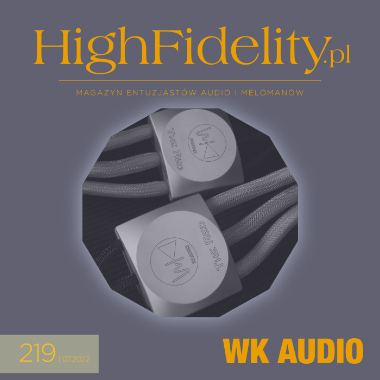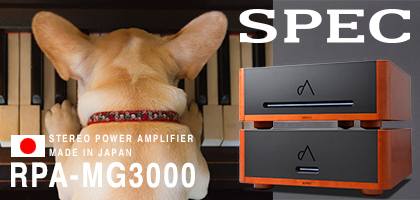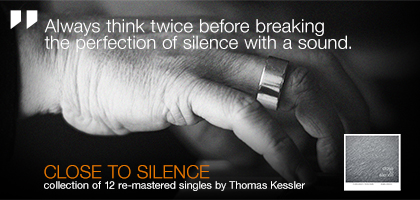ABOUT MEANING
Or why I don’t like color blue in audio
⌈ A 'SIGN' - 'something that has a contractual informative function, conveys certain contractual content, is a symbol of something - an image, graphic representation, lettering, movement of the hand, head, etc .; what serves to signify something.
⸜ Mały słownik języka polskiego, ed. Stanisław Skorupka, Halina Auderska, Zofia Łempicka, Warsaw 1969. ⌋
 T HAS ALREADY BEEN TWO MONTHS since the very important Polish holiday, which signifies the adoption of the first in Europe, and the second in the world - after the American - constitution, which went down in history under the name of the Constitution of May 3rd, and I still remember the day that preceded it celebrated in Poland as the Polish Flag Day. T HAS ALREADY BEEN TWO MONTHS since the very important Polish holiday, which signifies the adoption of the first in Europe, and the second in the world - after the American - constitution, which went down in history under the name of the Constitution of May 3rd, and I still remember the day that preceded it celebrated in Poland as the Polish Flag Day.
This day is devoted to a sign which - in general - makes it possible to recognize a country, territory, city or organization, and in this particular case Poland. The flag allows you to see who you are dealing with. As we are tribal creatures, this is an extremely important sign that builds a sense of community, belonging and gives a sense of security. No wonder that in most countries it is a symbol of great importance.

⸜ The Flag at the entrance to my apartment building – May 2nd 2022
So every year I feel sad to see how little we understand of it and how little we care about it. Let's start with the flag itself. Since it is obligatory to present it on this day, property managers - I'm talking about Krakow - take out flag-like crap from warehouses, attached to thin, often bent sticks and insert them into hastily screwed handles, bought at a DIY store for two zlotys.
The end of the 19th and the beginning of the 20th century, when modern nations were formed, that was the time when the flag mattered. In Poland, it is especially visible in the buildings from the Sanation period, when awakening patriotism at all costs was a state duty. Wandering around Krakow, I pay attention to the remnants of this glory, that is, the powerful, strong handles, designed to host thick flagpoles of flags - seen mainly on state buildings of that time, but also on some private ones. Today they are almost always empty.
Exactly the same mechanism was used by the communists after World War II - when you follow the main roads in Nowa Huta, a city that was supposed to be a "model working-class city", you can see densely embedded handles on the houses. The city was to be flooded with red during national holidays, occasionally interwoven with white. The rulers of Poland, both in the interwar period and later, knew that the flag was a powerful sign.
And that's why these twisted flagpoles, flags made of the cheapest, thin, crumpled and dirty material in white and red colors, make me sad. This year it was intensified by the fact that, although these contemporary handles are double ones, on very few buildings next to the Polish flag there was a Ukrainian one. And it would be a double sign - of both the friendship, there are over 2,000,000 friends from the East among us, and of the solidarity.

⸜ Blue is often used on stage - in the photo Al Di Meola during the concert that took place in Krakow on June 25, 2022
But that was not what I wanted to talk about. I mean, I wanted to, but only for the sake of introduction. In fact, I wanted to talk about blue color in audio, namely blue light emitting diodes, known as LEDs. Let me remind you that the LED is an electronic element that works like a classic diode, that is, it transmits current in one direction and is impermeable in the other, but it emits light on this occasion.
Although the principle of electroluminescence was discovered in 1907 by the English inventor, employee of Marconi Labs, H. J. Round, the first working diodes of this type were introduced only in 1962; they emitted infrared light - their descendants work in almost every remote control. The first light emitting diodes visible to the human eye were made shortly after, and they were yellow, then orange-red, and finally red.

⸜ Four different colors in the Leben CS-600X amplifier - red turns on if there the 6L6 tubes are installed instead of the EL34
|
The LEDs are often used to inform user about the device status. In audio, they are almost always with us. They are indicators which, on the one hand, facilitate operation, but on the other hand, guarantee safety. And that's why blue LEDs drive me crazy. When we talk about reporting anything, they are stupidly useless. In technology, two colors are the most important: red and green. The first is about danger and the second is about safety. They have meanings deeply ingrained in us, which is why they are so helpful.
Blue color, so willingly and so often chosen today by designers of audio devices, means nothing. Or actually it means something, but not what we think. It is a tool intended to make the buyer feel that he/she is becoming the owner of something modern. This is because blue has become a marketing sign, not a technical one. It is no coincidence that electric cars are marked in this way, both by blue illumination and by the use of this color in advertisements.
It's the same with audio. I remember that years ago when Marantz launched the first devices with a front panel consisting of three elements, the middle of which had undercut edges, blue light emitted from under the undercuts. Yet another memory concerns the amplifier '140', by the late Henryk Struss, who used one of the earlier blue LEDs in it, still in a dull-whitish version (my brother still has this amplifier today).
I think that the licensors of the MQA decoder followed a similar path, and reserved green for the "regular" MQA, but for the "better" one, the MQA Studio they chose blue. But this transfer of meaning from technology to commercial use can be seen most strongly in devices from China, which often glow blue, like a spooky Christmas tree. In this way, manufacturers from the Middle Kingdom are trying to emphasize the meaning of this color and give us even more of it.

⸜ A good example of the use of colors other than red and green are Boulder devices, as in the '812' model
Therefore, it is with great pleasure that I test devices that use red and green indicators, as they have a technical justification. And that is why I am so relieved when I see a use of white LEDs, because white means nothing, but also does not force us to do anything. So it can be said that it is a neutral sign. I treat the orange color in a similar way, historically the first one, which was adopted by Accuphase as its hallmark. Ultimately, it was founded in 1972, exactly when the first LEDs in this color appeared on the market.
Nowadays, audio designers use light emitting diodes without much thought. They mix different colors regardless of their true meaning and even in my beloved Leben CS-600X amplifier we have red and green colors, denoting two types of output tubes, but there is also orange, which means power on, and blue to inform you that the amplifier is ready for operation. The Ayon Audio and Soulution companies, whose devices I also use, chose only red. Boulder, on the other hand, uses white and orange LEDs, which turns out to be a pretty good choice.
Of course, you can overdo it even with the right color, as evidenced by the illumination of electron tubes in McIntosh devices. Admittedly, the color is green, and therefore “friendly” to the eye, but it seems too unambiguous and kitschy to me. But that's just my opinion, not a fact. Because the market ultimately decides everything. And the market has been "set" by ad makers so that "more" is "better" and that "blue" equals "modern", "zero emission", "electric", "green". And we won't win with advertising.

⸜ A whole range of flags on the Kościuszko Mound in Krakow. Polish and Ukrainian flags are fluttering at the top, and a repeated Polish flag and the flag of the Mound are placed below
Nevertheless, looking at audio devices, and we are audiophiles after all, and the products used for music reproduction are as important to us as the music itself, let's think that everything matters in them, including colors. And it would be good for a given color to mean exactly what it should. And the blue diode introduced for sale in 1989 does not mean anything. ■
WOJCIECH PACUŁA
Chief editor
|
















 T HAS ALREADY BEEN TWO MONTHS since the very important Polish holiday, which signifies the adoption of the first in Europe, and the second in the world - after the American - constitution, which went down in history under the name of the Constitution of May 3rd, and I still remember the day that preceded it celebrated in Poland as the Polish Flag Day.
T HAS ALREADY BEEN TWO MONTHS since the very important Polish holiday, which signifies the adoption of the first in Europe, and the second in the world - after the American - constitution, which went down in history under the name of the Constitution of May 3rd, and I still remember the day that preceded it celebrated in Poland as the Polish Flag Day.







